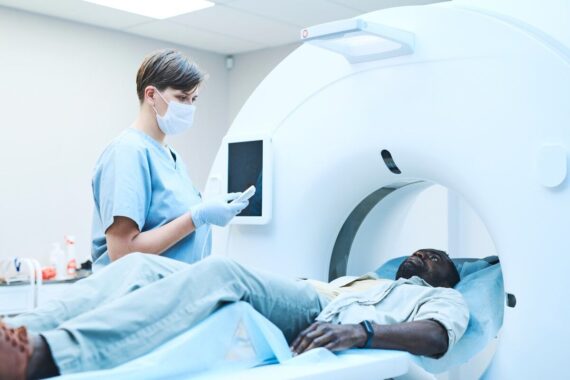MPs raise concerns about slow pace of community diagnostics rollout

The first report into the rollout of community diagnostic centres (CDC) by a dedicated all-party parliamentary group (APPG) has identified issues including a lack of GP referrals.
In September last year, only 6.5% of NHS diagnostic tests in England took place at a CDC, according to the report from the All-Party Parliamentary Group for Diagnostics, compiled by The Royal College of Radiologists.
The report said there were ‘various barriers to healthcare providers referring patients to CDCs, now that access has been opened to all primary care referrers’, including the digital referral system.
‘GPs follow streamlined procedures for referring patients to hospitals, often requiring just one click. In comparison, referring patients to a new CDCs can be more complex, possibly causing hesitation,’ it said.
‘Therefore, working with GPs is crucial to simplify the referral process and remove barriers, ensuring smooth and equitable access to CDCs for all patients.’
CDCs around England are offering ‘one stop shop’ tests including CT and MRI scans, ultrasounds and blood tests. NHS England said in August last year that they would also start doing tests for asthma, COPD, cardiovascular disease and heart failure ordered directly by the patient’s GP.
As a ‘minimum provision’ they need to be covering imaging, physiological measurement and pathology, but the APPG report said that ‘additional services, tailored to meet local needs, have and should continue to be integrated to confirm CDCs as true “one-stop shops” for patients’.
‘Unfortunately, a lack of data and research limits the assessment of the programme’s effectiveness in achieving this goal,’ it added.
The APPG also warned that despite NHS England being ‘committed’ to equipping CDCs with up-to-date machines ‘challenges with basic infrastructure and data sharing, plus inconsistent digital advancements, persist, underscoring the need for additional funding for robust digital infrastructure’.
In August, the Government announced an additional 13 CDCs would be set up, eight of which would be led by the private sector. According to the APPG report, 127 CDCs are now operational with ‘at least one regular or large-sized CDC in each Integrated Care System (ICS) in England’.
‘However, the pace of activity is slow, as only 6.5% of the total diagnostic activity reported on by NHSE occurred in CDCs in September 2023, and around 5 million tests have been conducted since July 2021 against a target of 17 million by 2025,’ the APPG report said.
‘While collaboration with the private sector has expanded service provision, persistent high demand and limited capacity present ongoing challenges, and the impact on patient outcomes remains unclear, emphasising the need for continuous evaluation and transparency,’ it added.
To boost referrals to CDCs, system leaders also need to ‘conduct outreach with primary care providers within the ICS to increase awareness of the new site’, the report said.
‘If patient referrals from these providers do not reach the expected level, leads should engage in personalised outreach. This approach addresses misconceptions, resolves hesitations, and tailors communication to improve collaboration for effective CDC integration in healthcare.’
The report also highlighted issues with data sharing and interoperability between CDCs, primary and secondary care, with a recommendation to ‘prioritise bolstering digital infrastructure and patient data sharing’.
‘NHSE should develop and enforce interoperability standards for digital tools used within CDCs to ensure seamless data exchange and collaboration between primary and secondary care settings. This standardisation will enable clinicians to access patient information across different points of care, improving coordination and decision-making.’
The report also criticised the location of the CDCs, many of which were initially set up at acute hospitals, although evidence suggests they are best placed ‘in the heard of communities’ as this ‘significantly improves access to and uptake of diagnostic services, especially for those less likely to seek healthcare’.
‘Challenges remain as only about half of CDCs are situated in the heart of communities due to Trust budget deficits, high upfront costs, and risks associated with private renting hindering ICSs from making the “brave” choice,’ the report said.
To overcome ‘low risk attitudes’ which stop ICSs from choosing locations such as shopping centres to place their CDCs, NHS England should ‘provide incentives’ to those who do choose community-based locations meeting deprivation criteria, the report recommended.
APPG chair Maggie Throup MP said the inquiry ‘identified clear benefits to the programme’.
‘Diagnostic capacity has been expanded to bring down waiting lists in some areas and, when situated in the heart of communities, CDCs offer convenient services to those who may not typically seek healthcare.’
‘However, challenges persist, especially in terms of delivery speed,’ she added.
She also highlighted ‘workforce capacity’ a ‘limiting factor’ for the success of the programme.
‘It is impossible to realise the benefits of the programme without adequate staffing to operate CDCs,’ she said.
The Government has said all 160 centres it has promised will be open by March this year, a year ahead of the original March 2025 target.
APPG reports are not official Government reports as they are made up of members of the House of Commons and the House of Lords with a special interest in a certain topic.
Pulse October survey
Take our July 2025 survey to potentially win £1.000 worth of tokens

Visit Pulse Reference for details on 140 symptoms, including easily searchable symptoms and categories, offering you a free platform to check symptoms and receive potential diagnoses during consultations.










